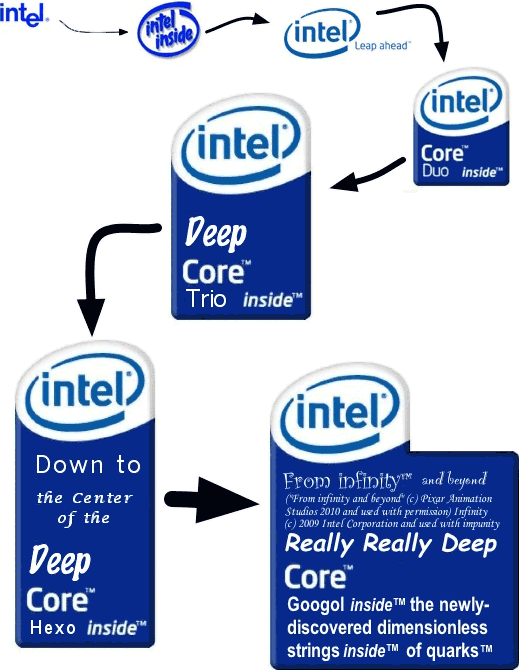My wife seldom pays attention to the latest trends in technology unless it directly affects her business (photography). I will occasionally tell her about major events, such as the switch of Apple products from PowerPC to Intel CPUs, or whether or not Bono has decided to use his left or right hand while signing his name for the latest iPod engraving add-on feature.
The other day, however, I was explaining how Intel had developed new logos to reflect the new “Core” technology, and she said, “You mean it’s not that ‘inside’ swoopy thing anymore? Let me see it.”
When I showed her the new “Intel: Core™ Duo inside™” logo, she . . . laughed. Out loud. “What a ridiculous thing,” she commented. “Three – no, four different fonts, all different sizes, two trademark terms that are ordinary English, and a registered-sign. Next thing you know, they’re going to need a bigger logo because that’s too small to hold all the buzzwords.”
Then she looked at me with a twinkle in her eye and said, “You should do a Lite Side on that.”
So, dear reader, thanks Lori the Wise, I present to you the Lite Side’s
Roadmap to Intel’s Past, Present, and Future Icons
In this diagram (below), you can see Intel’s original logo in the upper left corner. I don’t know what the dropped-down “e” says to you, but to me it says, “broken.”
Next we have the swooshy “intel inside” logo adorning millions of tech department shoe soles, where they become adhered after being peeled off of various desktop computers and laptops. (Peeling off logos is what you do while you wait for your computer to reboot; that’s one of the reasons Apple wisely decided not to include the logo on the new MacBook Pros.)

The current Core™ Duo inside™ logo and its family comes next. You should know there are currently over a dozen variants of this logo for the various technologies Intel is deploying, such as the Intel Core Quattro™ Dual-Core Double-Header, the Intel Grounded Power Cored™ for users who want to use (Windows) laptops for more than an hour or so, and the the Intel Post-Graduate Cored™ for people who need to have automatic backups of their theses. Thesi? Thesesi? You get the point.
Next come the “intel Deep Core™ Trio inside™” logo, destined to debut in 2007. Even though Intel is currently developing quad-core technology, Trio refers to each core, making a grand total of six (three dual) cores. This logo will be superseded by the next in only fourteen hours, though, making it a collector’s item next year and an eBay-sponsored scavenger hunt item in 2015.
The next logo in the series will be the “intel Down to the Center of the Deep Core™ Hexo inside™” logo, which will announce the deployment of the new 2 x 6 = 12 core processors, each 40 centimeters on a side with a hollow space accessible from outside the computer into which the user must shove dry ice every fifteen minutes to keep the computer from exploding.
Heat dissipation will be the cause of the effective death of high-density computing until the invention of multidimensional quantum processors in 2009. In these processors, significant amounts of the computing power is shunted to other processors in other dimensions, reducing the heat output in this one.
The last logo shows the eventual effect of the Disney-Pixar deal; Steve Jobs will eventually become so influential that Intel will be forced to sign a partnership agreement with Pixar just because of some off-the-cuff remark Jobs makes at a dinner party on a cruise ship somewhere off the coast of Bakersfield in the year 2020. The “From infinity™ and beyond (“From infinity and beyond” (c) Pixar Animation Studios 2010 and used with permission) Infinity™ (c) 2009 Intel Corporation and used with impunity Really Really Deep Core™ Googol inside™ the newly discovered dimensionless strings inside™ of quarks™” processor sports no less than seven fonts, five trademarks, two copyrights, one registered symbol, and represents a label so large it will cover a significant fraction of whatever display it is attached to – if it were not for the fact that the display will be holographic and float in front of the logo.
Computers using this processor, if fully present in the 3-dimensional universe, would be 70′ tall and require an iceberg to melt per day to keep cool. Thanks to new multidimensional technology, however, they’ll fit inside the size of a thumbnail-sized sticker that is affixed to your thumbnail. The logo will be the largest part of the device.
And it will have a built-in iPod.
Short link: http://goo.gl/b3OTwU

